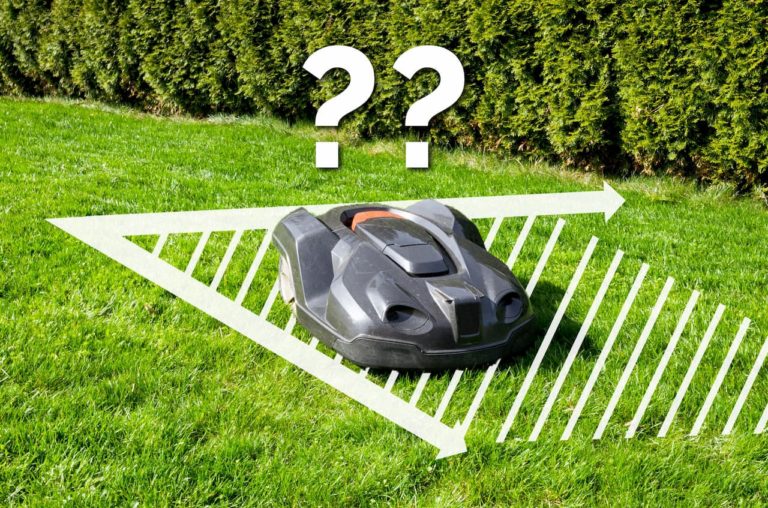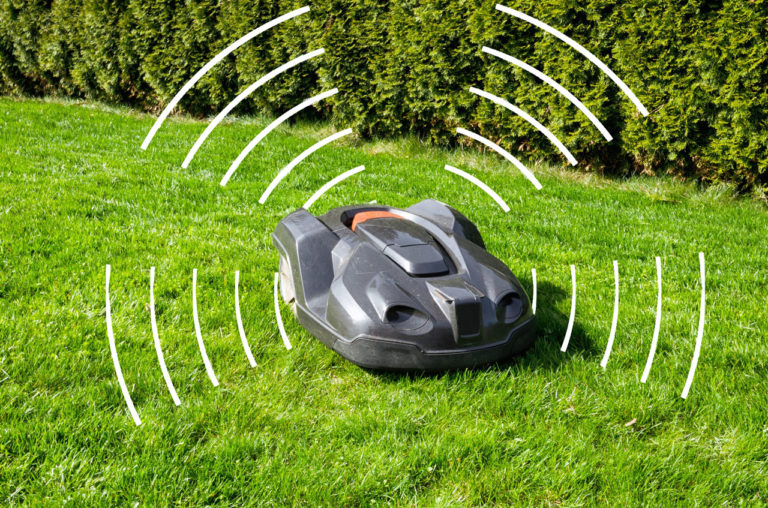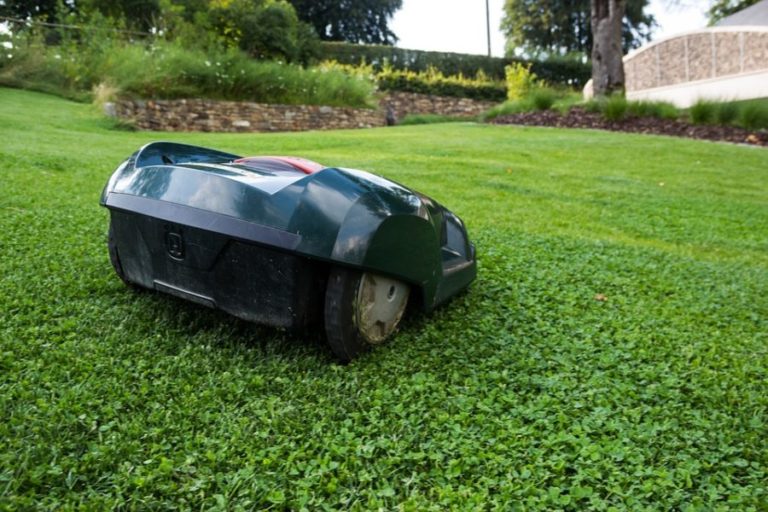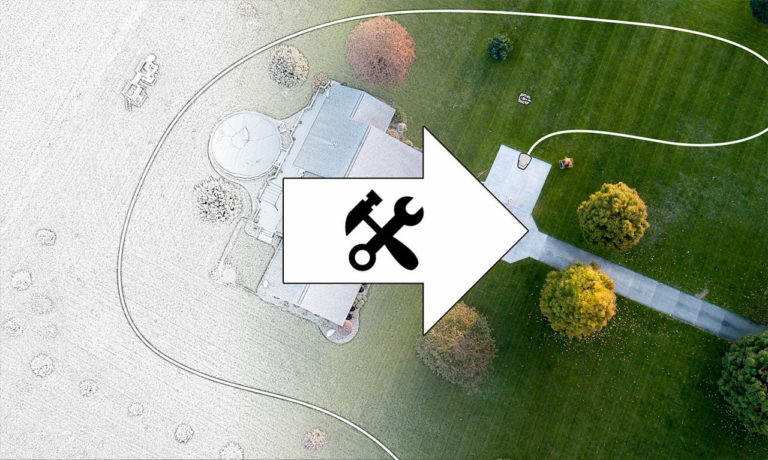Not every yard is absolutely level; some have dents, small holes, larger holes, bumps or even ditches. Can you even operate a robotic mower on an uneven ground like this? And can’t you do something about these bumps? Here I will explain this all to you.
Can the robotic mower mow on uneven lawns? Basically, most robotic mowers can mow on uneven lawns, as they have quite large wheels. Of course, this is dependent on the degree of unevenness. Holes over 2 inches deep usually cause problems. In any case, it makes sense to remediate unevenness if possible.
What the robotic mower can handle, where the lumps in your yard might come from, and what you can do about them, I will explain in the following.
Contents
How much unevenness can the robotic mower handle?
Holes and small hollows
Most robotic mowers usually do not have any major problems with small unevenness. If your yard has a lot of small holes, your robotic mower should be able to handle them without any problems, even if they are several centimeters deep.
It becomes problematic when the holes are very deep and very wide. From 2 inches depth and upward it can be difficult. If the hole is so wide that the mower sinks completely into the hole, it may hit the other side of the hole and have its shock sensor triggered.
It can also get stuck with its edges if the holes are too deep. If you have holes in your yard that are 2 inches or deeper and in which one wheel of the robotic mower would fit completely, or even the whole robotic mower, you should repair them.
Especially if it is wet and/or leaves accumulate in the holes, the risk of the robotic mower getting stuck in them increases.
Larger troughs and divots
With larger hollows and depressions there are completely different problems against which the robotic mower has to fight. Here there is the danger that they will fill up with rain and form puddles or mud pits. The robotic mower is not waterproof. If it falls too deeply into such puddles, it can be damaged.
Whether puddles form when it rains depends on many factors, of course. For example, what is the condition of the depression- can the water run off somewhere? The strength and duration of the rain also influences whether puddles form. If puddles have not yet formed in the hollows in your lawn during a rain shower, this does not mean anything.
The next time it rains hard or continuously, you should take a look at it. If a small lake then forms there, you will have to mend it so that your robotic mower does not drown while mowing. Or you don’t let it mow when it rains, which you can achieve with a rain sensor. But whether a rain sensor makes sense in general is also a bit questionable, as I have explained in this article.
By the way: If you often observe that the water in your yard accumulates, this can also be a sign of severe soil compaction. This is bad for your lawn because the roots get little oxygen and the bioactivity in the soil decreases. You should aerate it if you notice this happening.
Tips for fixing the bumps
If you have noticed that the bumps are too big for your robotic mower, you must repair them. Here are a few tips on what you can do.
Repairing small differences in height
For smaller differences in height up to 1 inch you can easily make a repair. First of all, you should cut the lawn as short as possible in the appropriate place. Then apply a little soil to the area in question – you can add some lawn fertilizer as a supplement.
You can then press the soil down with your shoes or, in the case of larger areas, with a board and, if necessary, add more soil until the difference in height is equalized. Do not press the earth too tightly, however, to ensure a certain amount of air circulation. In addition, the lawn must be able to grow through this, so only press down very lightly.
The lawn can then make its way through the newly applied soil, if the layer is not too thick, and continue to grow at the new, higher level. This works up to a height difference of about 1 inch or sometimes 1 ½ inches.
Repair of larger height differences
Since you have to apply thicker layers of soil here, the lawn will not be able to grow through the soil. So you have to take a different approach.
For larger height differences you can use different procedures. No matter how you do it, you will either have to reseed the lawn in those places, or you will have to transplant the lawn skillfully.
Method A
Larger hollows or holes can also be filled with earth as described above. You proceed exactly the same way, i.e. you fill up and press the earth in between until the difference in height is equalized. If you want to transplant the lawn, you should of course dig it up first.
Method B
If you want to level out larger differences in height and you do not want to fill it up with too much soil, the only thing that helps is to break up the lawn with a plough. This makes it easier to spread the soil over larger areas and level out height differences. Especially if the differences in height in your yard are caused by moles in the ground, you should use the ploughing method. You can of course also use a spade on a smaller scale.
New planting
Unfortunately, the two methods mentioned above require the sites to be replanted. You can either reseed the lawn, or cut out the lawn in other places and then replant it.
When sowing the lawn you can proceed as usual. Remember that robotic mowers are not allowed to mow young grass, but that it must first grow to 4 inches and must be mowed manually at the beginning.
Depending on the type of lawn, it may not be mulched for several weeks after sowing. Constant driving by the robotic mower also puts too much strain on the young lawn. There are possibilities to temporarily exclude certain areas of your lawn from mowing by the robotic mower.
When transplanting lawns, proceed as follows: Don’t do it in dry weather. The lawn should first be mowed briefly, to about 1 inch. Then you can cut the lawn into handy slabs. Because of the large amount of soil that adheres to the lawn, these slabs can be quite heavy, so you should not cut them too large.
To cut the lawn, it is best to use a lawn edger. This device works similar to a spade. You may even have used one when laying the boundary wire.
You need to get to the roots, so you should remove some soil from the outer edge of the area you want to repair. A horizontal cut must then be made under each turf to separate it from the ground. This can be done with a long metal spatula or a butter knife. There must be enough grass roots left on the plates so that they do not fall apart and the lawn can grow well after transplanting. The adhering soil should be at least 1 inch thick.
After you have levelled the ground using one of the above methods A or B, you can now transplant the turf slabs again. There should be no gaps between the grass tiles, so make sure there are no gaps between them. You can then use a roller to press the lawn tiles back into place.
It is important that the lawn is well watered after laying so that the slabs are completely penetrated by water. In the following weeks, you will need to continue watering the lawn very regularly until the roots have grown longer and your lawn is better able to supply itself with water. The growing phase lasts 4 to 5 weeks.
How does the unevenness in the lawn come about?
There are a large number of causes for unevenness in the lawn, of which I can only mention a few here.
- New construction: In the case of a new building, it is not uncommon for the yard to be somewhat uneven at the beginning. Over time, this can even out somewhat. It is also possible that the ground was not properly levelled before the lawn was laid out
- Moles: Underground mole passages can cause very deep depressions upon collapsing. Other animals such as voles can also cause such depressions
- Former pasture: If your yard used to be a grazing ground for animals, it is absolutely normal that it has unevenness.
- Debris or tree remains in the soil: Stony debris or root remains of a tree can cause elevations in the yard.
- Waterlogging: Sinkages in the ground can result from waterlogging. The water penetrating into the ground cannot drain off properly. Aerification can counteract this if the damming layer is not at too great a depth. Clay and loamy soils are particularly at risk.
- Pipe burst: A burst pipe under your lawn leads to the same problems as waterlogging. It can also just be a slightly leaking pipe. If you turn off your water and the water meter continues to move, this can be a sign that a spot is leaking.
- Sprinkler system: Even a sprinkler system that is not working properly can cause unevenness. Similar processes are set in motion as in the case of waterlogging or a burst pipe, when the sprinkler system leaks or the water is no longer distributed properly due to clogged nozzles.
So that you don’t have to constantly repair your lawn, you should check whether one of these causes applies to your yard and eliminate it.
Related questions
What is the maximum gradient that robotic mowers can manage? Most robotic mowers can now manage gradients of up to 35%. More expensive models are also able to cope with gradients of up to 45%. On even steeper gradients, there are only a few models that can cope with the gradients.
How do robotic mowers cope with wet lawns? While some robotic mowers can cope particularly well on wet lawns such as the Automower, which mows wet lawns better than it does dry) there are other models, especially the heavier ones, which are better off not mowing wet lawns.




